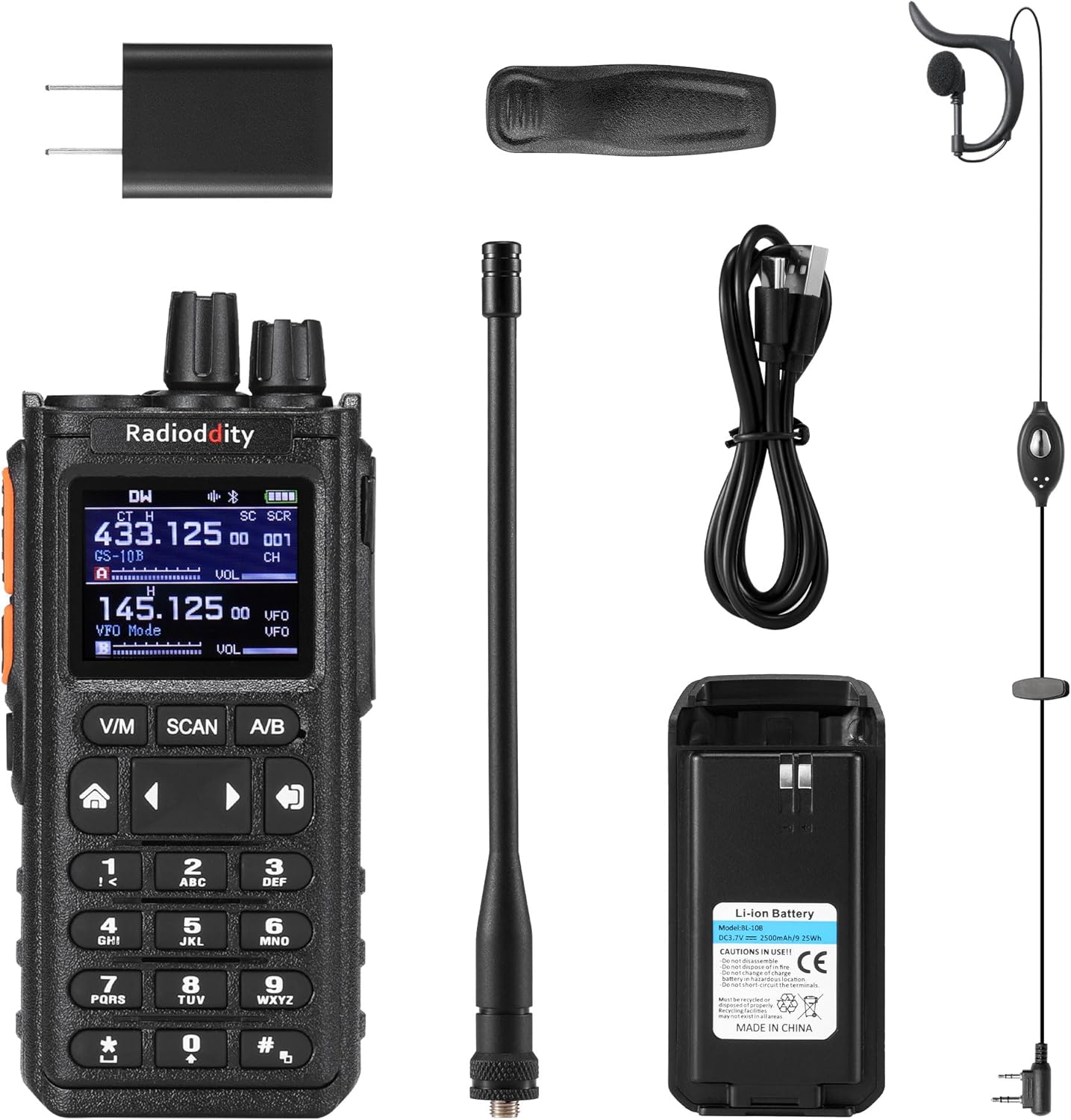
Overview
The Wouxun KG-Q10H is a compact quad-band handheld transceiver designed for amateur radio operators who want 1.25 m, 2 m, 6 m, and 70 cm transmit capability in a single handheld unit. It’s a versatile radio with a full-color dual-channel display, GPS/location functions, wide receive coverage, and modern conveniences such as USB-C charging and a large rechargeable battery.
What the radio is and who it’s for
This model is aimed at hams who value multi-band flexibility in a portable format. It’s perfect for those who want to work local repeaters on 2 m and 70 cm, explore the 6 m “magic band,” and use 1.25 m where available, all without carrying multiple radios. It also appeals to users who appreciate features like GPS and modern charging options. However, it’s not ideal for operators who require built-in digital voice modes or those looking for the smallest, most basic HT possible.
Key specifications
• Quad-band transmit: 1.25 m (220 MHz), 2 m (144 MHz), 6 m (50 MHz), and 70 cm (430 MHz)
• Broad receive coverage across VHF and UHF ranges, including airband reception in AM
• Adjustable transmit power with multiple settings, typically reaching up to around 6 watts depending on the band
• 3000 mAh Li-Ion battery with USB-C charging
• Size: approximately 132 × 62 × 37 mm and around 238 g without antenna
• Full-color dual-channel display with clear readability and dual watch capability
First impressions and build quality
The KG-Q10H feels sturdy and solid in the hand, with a textured shell that provides good grip. Its design follows a familiar handheld format with a top-mounted volume knob and side buttons that feel well-built. The full-color display is bright and sharp, making it easy to identify which band or channel is active. The included 3000 mAh battery gives a sense of reliability for extended outdoor or emergency use, and the USB-C port makes it easy to charge from power banks or modern adapters. Overall, build quality is high for its price range.
User interface and display
The color dual-display screen is one of the best features of the KG-Q10H. It shows both active channels simultaneously, allowing easy monitoring of two frequencies at once. The menu system offers plenty of customization options, including tone settings, display themes, and scanning preferences. The interface is fairly intuitive for anyone experienced with Wouxun radios, though beginners may need time to get used to navigating through the options.
Transmit and receive performance
Transmission quality is clear, with good modulation and dependable power output on all four bands. The radio performs well on both simplex and repeater operations. Receive sensitivity is solid, providing clean audio and minimal background noise. The inclusion of airband reception adds versatility, letting users monitor aviation frequencies. In field use, the KG-Q10H maintains stable connections and performs similarly to higher-priced handhelds.
Battery life and charging
Battery performance is excellent thanks to the 3000 mAh capacity. Light-to-moderate use can easily last an entire day or more, while heavy transmit activity may still provide several hours of runtime. USB-C charging is a modern upgrade that many older HTs lack, allowing convenient charging from laptops, power banks, or car adapters without the need for a proprietary charger.
Antenna and accessories
The KG-Q10H comes with a dual-band or multiband antenna, belt clip, and wrist strap. While the stock antenna performs decently, upgrading to a higher-gain aftermarket antenna can noticeably improve both transmit and receive range. The SMA connector allows easy antenna swaps, and the radio can also be connected to external antennas for mobile or base setups.
Features worth noting
• Quad-band transmit and wide receive coverage
• Full-color dual-display with customizable themes
• GPS positioning and location data display
• NOAA weather reception and alert functions
• Cross-band repeater functionality
• Multiple scan modes and dual-watch monitoring
Software, programming, and updates
Programming can be done through the keypad or more efficiently using Wouxun’s PC software (CPS) and a programming cable. The software interface makes it simple to organize memory channels, tones, and settings. For large repeater lists or complex configurations, PC programming is highly recommended. Firmware updates are occasionally released to improve stability and performance.
Real-world pros and cons
Pros:
• True quad-band transmit capability in a single handheld
• Excellent battery life with modern USB-C charging
• Bright color display and modern menu system
• Solid audio and strong receiver performance
• GPS and weather features useful for outdoor and emergency use
Cons:
• No built-in digital voice modes (DMR, D-STAR, etc.)
• Menu system can be overwhelming for new users
• Requires programming cable and software for full setup convenience
• Slightly bulkier than single or dual-band handhelds
Price and value
At a mid-range price, the Wouxun KG-Q10H offers strong value for its combination of features. Few handhelds provide true quad-band transmit capability with modern conveniences like GPS and USB-C charging. For amateur operators who want flexibility across multiple bands without the need for several radios, this model offers excellent performance and reliability at a fair price.
Practical tips before buying
• Verify you are purchasing the amateur (H) version, not the GMRS variant (G)
• Use PC programming software to manage frequencies easily
• Consider upgrading the antenna for maximum range
• Keep firmware updated for best performance
Final verdict
The Wouxun KG-Q10H is a feature-rich, dependable quad-band handheld that combines classic ham radio versatility with modern technology. It’s ideal for hobbyists, field operators, and emergency communicators who want wide coverage, long battery life, and ease of use. While it lacks digital voice modes, its analog performance and practical design make it one of the most capable and convenient handhelds in its class.













